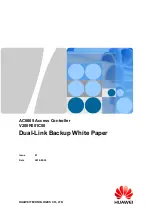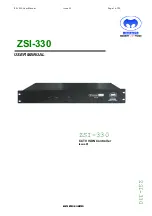
AC6605 Access Controller
Dual-Link Backup White Paper
1
Dual-Link Backup
Issue 01 (2012-05-30)
Huawei Proprietary and Confidential
Copyright © Huawei Technologies Co., Ltd.
5
Setting Up the First Tunnel
1.
After the AP obtains its own IP address and IP addresses of the two ACs, it sends a
Discover Request packet to both ACs to discover ACs. If the AP obtains only its own IP
address, it broadcast a Discover Request packet to discover ACs.
2.
If the ACs are working properly, they send a Discover Response packet with the
dual-link backup flag, workload, and priority to the AP.
3.
After receiving the Discover Response packets, the AP compares the priorities and IP
addresses of the ACs to select an AC and establishes a CAPWAP tunnel with the
selected AC. The AC with a smaller priority value becomes the active AC. If the ACs
have the same priority value, the AC with a lower workload becomes the active AC. If
their workloads are also the same, the AC with smaller IP address becomes the active
AC.
If an AC fails to return a Discover Response packet, the AP selects the other AC to set up the CAPWAP
tunnel. The tunnel set up first may not be the primary tunnel. The AP will determine the primary and
backup tunnels after it successfully establishes tunnels with both the two ACs.
4.
The subsequent negotiation and configuration delivery processes are the same as those
for setting up a single CAPWAP tunnel.
5.
After the tunnel is set up, the AC delivers configurations to the AP. When the AP works,
STAs can go online and use network services.
Setting Up the Second Tunnel with the Other AC
1.
The AP determines to set up a CAPWAP tunnel with the other AC only when the
Discover Response packet sent by the first AC contains the dual-link backup flag. The
AP starts to set up the second tunnel after the first AC has delivered configurations to the
AP. This avoids repeated configuration delivery.
2.
If the AP has obtained the other AC's IP address, it sends a unicast Discover Request
packet to this AC, and then sends a broadcast Discover Request packet to discover ACs.
If the AP has not obtained the other AC's IP address, it sends a broadcast Discover
Request to discover ACs. The AC that has set up a CAPWAP tunnel with the AP ignores
the Discover Request packet.
3.
If the AC is working properly, it returns a Discover Response packet containing the
dual-link backup flag and priority to the AP.
4.
The AP knows that the dual-link backup function is enabled after receiving the Discover
Response packet, and saves the priority of the AC.
The second AC will not become the active AC even if it has a higher priority than the first one. The AP
switches traffic to this AC only after it sets up a CAPWAP tunnel with the AC.
5.
The AP sends a Join Request packet, notifying the AC that the configurations have been
delivered. The AC will not deliver configurations to the AP after receiving the Join
Request packet.
6.
After the tunnel is set up, the AP compares the priorities and IP addresses of the two ACs
and determines the active and standby ACs. The AP performs a revertive switchover if
the second AC becomes the active AC.
NOTE
NOTE











































